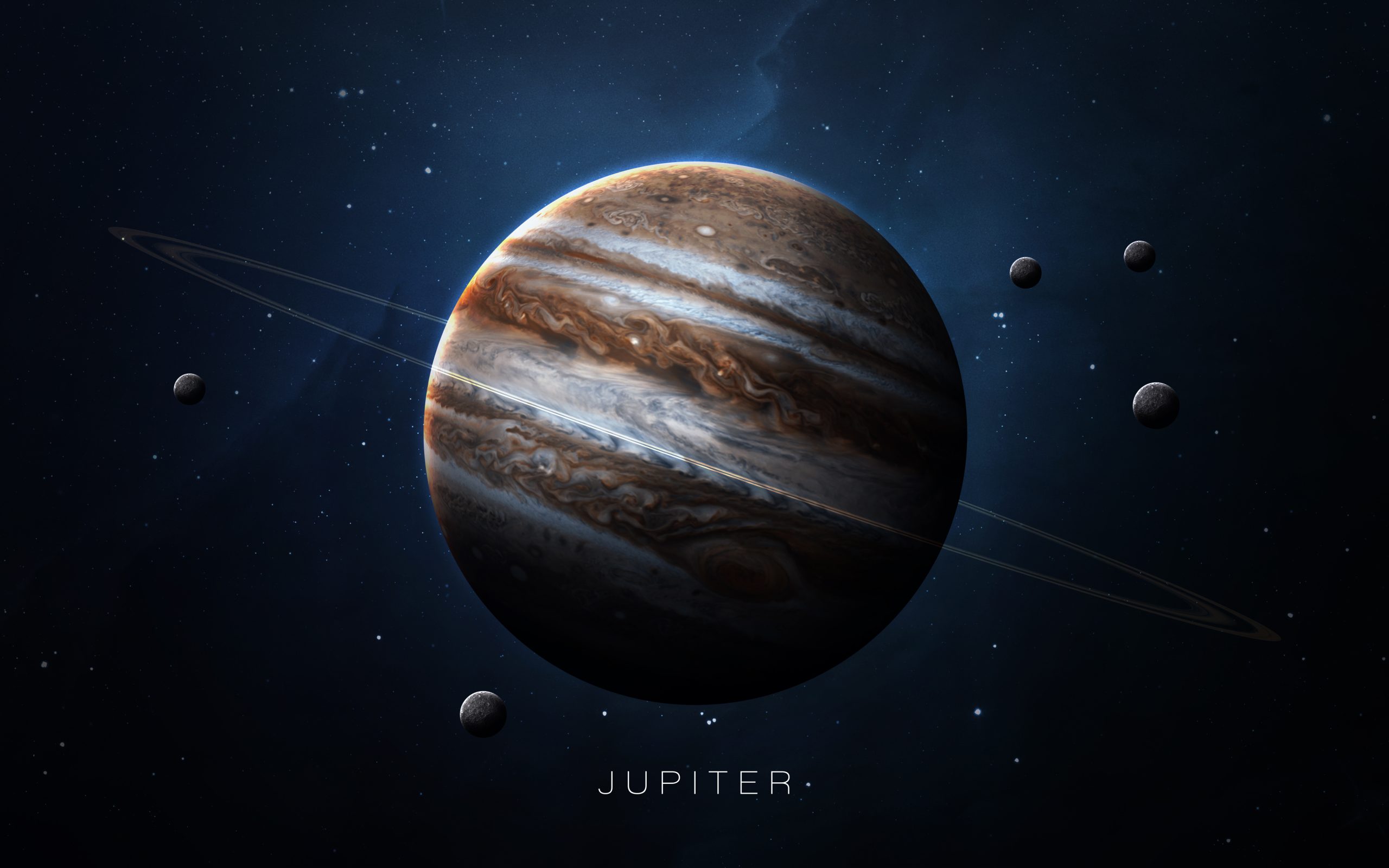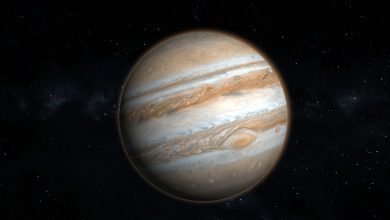The Giant Guardian: 10 Intriguing Facts About Jupiter

Jupiter, the behemoth of our solar system, has long captivated the imagination and curiosity of humanity. Its massive size and profound gravitational influence have earned it the title of the ‘giant guardian’ of the celestial neighborhood.
This moniker is not without merit; Jupiter‘s presence has played a critical role in shaping the orbital dynamics of our solar system and in protecting the inner planets from potential threats.
In this blog post, we’ll explore 10 fascinating aspects of this gas giant, from its colossal size and rapid rotation to the enigmatic Great Red Spot and its multitude of moons. By unraveling these mysteries, we not only gain insight into Jupiter’s nature but also deepen our understanding of the solar system at large.
Join us as we voyage through the intriguing facts about Jupiter that highlight its significance, not just as a planet, but as a guardian of Earth and its cosmic neighbors.
1. The Colossal Size
Jupiter’s commanding presence in the solar system is largely due to its sheer size, making it the undisputed giant among planets. This colossal world is approximately 11 times wider than Earth, capable of fitting over 1,300 Earths within its voluminous expanse.
Its grand scale doesn’t just dominate visually but also exerts a powerful gravitational pull, impacting the orbits of the other celestial bodies nearby.
This immense size is a remarkable feature that not only sets Jupiter apart but also plays a significant role in the intricate ballet of our solar system’s dynamics.
The enormity of Jupiter acts as a constant reminder of the vastness and diversity intrinsic to the cosmos, inviting us to explore and understand the forces at play in the celestial realm.
2. A Rapid Spinner
Astonishingly, despite its massive size, Jupiter is the fastest-spinning planet in our solar system. This gas giant completes a full rotation on its axis in just under 10 hours, resulting in the shortest days of all the planets.
This rapid rotation is a spectacle of nature, illustrating the dynamic and diverse conditions that govern celestial bodies.
The speed at which Jupiter spins also contributes to its flattened shape at the poles and bulging at the equator, known as its equatorial bulge. This rapid spin influences various aspects of Jupiter’s environment, from atmospheric patterns to the distribution of its cloud bands.
The fact that such a colossal planet can rotate at this speed is a testament to the vast and complex mechanisms at play within our solar system, showcasing the incredible forces that shape our cosmic neighborhood.
3. The Great Red Spot
The Great Red Spot, perhaps Jupiter’s most iconic feature, is a colossal storm that has been raging for at least 400 years, possibly even longer. This mammoth storm is so large that three Earths could fit inside it.
The mystery of the Great Red Spot lies not only in its sheer size but also in its longevity. Unlike storms on Earth, which dissipate after a few days or weeks, Jupiter’s Great Red Spot has sustained itself for centuries, thanks to the planet’s lack of a solid surface and its dynamic atmosphere, which is fueled by high-speed winds reaching speeds of about 432 km/h (268 mph).
Scientists continue to study this enigmatic storm in hopes of understanding more about its origins, structure, and potential for longevity.
The Great Red Spot remains one of the solar system’s most intriguing natural phenomena, a swirling, tempestuous beacon on the face of the gas giant, highlighting the complex and dynamic nature of Jupiter’s atmospheric behavior.
4. A Multitude of Moons
Jupiter’s dominion extends well beyond its turbulent atmosphere, reigning over an astonishing assembly of moons, with more than 79 known satellites orbiting the gas giant. Among this celestial fleet, Europa and Ganymede stand out not only for their size but also for their captivating features and potential for hosting life.
Europa, with its icy surface, is believed to harbor a vast ocean beneath, raising speculations about the possibility of marine life in its subterranean waters. Ganymede, being the largest moon in our solar system, surpasses even the planet Mercury in size.
It is unique for having its magnetic field and is thought to possess a subsurface ocean, like Europa. These moons are more than just natural satellites; they are windows into the potential habitability of other worlds, highlighting Jupiter’s role in hosting a diverse array of celestial phenomena.
The exploration of Europa and Ganymede could unveil secrets about the conditions necessary for life, offering new insights into the cosmic lottery of where and how life might exist beyond Earth.
5. The Magnetic Giant
Jupiter’s magnetic field is a colossal force, dwarfing that of Earth’s by an incomprehensible margin. It is the strongest magnetic field of any planet in our solar system, approximately 20,000 times more powerful than Earth’s.
This immense magnetic field extends millions of kilometers into space, forming a vast magnetosphere that can even envelop Saturn’s orbit under the right conditions.
The magnetic field is generated by the rapid rotation of Jupiter’s dense core, which is thought to consist of metallic hydrogen.
This unique substance, combined with Jupiter’s swift rotation, creates a dynamo effect that fuels its magnetic might.
The scale and strength of Jupiter’s magnetic field are not only fascinating in their own right but also have profound implications for the gas giant’s atmosphere and its moons.
This magnetic powerhouse shields the planet and many of its satellites from cosmic radiation, playing a crucial role in the potential habitability and geological processes of moons like Europa and Ganymede.
Jupiter’s magnetic field is yet another testament to the planet’s dynamic and extreme nature, offering invaluable insights into magnetic phenomena throughout the cosmos.
6. Atmospheric Mysteries
Jupiter’s atmosphere, a thick blanket of mystery and grandeur, embodies the planet’s dynamic and extreme nature. This colossal gas giant’s atmosphere is composed primarily of hydrogen and helium, closely mirroring the primordial solar nebula from which the solar system was born.
The most visually striking feature of Jupiter’s atmosphere is the intricate array of bands and zones that encircle the planet. These bands and zones are essentially alternating layers of cloud formations, with the darker bands known as “belts” and the lighter ones referred to as “zones.”
The belts are regions of descending gas, marked by higher temperatures and a more dense composition, whereas the zones are characterized by rising gas, cooler temperatures, and less density. This complex interplay creates the breathtaking visual spectacle that Jupiter is known for, painting a portrait of atmospheric motion on a massive scale.
The dynamics behind these features are influenced by Jupiter’s rapid rotation and the heat emanating from its core, leading to the high-speed jet streams that further define the belts and zones.
This atmospheric dance, visible even through amateur telescopes, holds keys to understanding not only Jupiter’s weather systems but also offers clues about atmospheric behaviors in exoplanets across the galaxy.
7. Ring System
While Saturn’s majestic rings often steal the spotlight in discussions about planetary ring systems, it’s a lesser-known fact that Jupiter, too, possesses its own set of rings. Unlike Saturn’s easily visible and bright rings, Jupiter’s ring system is rather faint and largely comprised of dust particles.
This ethereal ring system was first discovered in 1979 by the Voyager 1 spacecraft, revealing an unexpected aspect of the gas giant.
The rings are mainly composed of small, dark particles ejected from its moons, primarily from meteoroid impacts on the moons Metis, Adrastea, and Thebe.
These particles then orbit Jupiter, forming its subtle yet fascinating ring system. Jupiter’s rings consist of the main ring, a halo ring, and two gossamer rings, reflecting a different kind of beauty compared to Saturn’s.
Far from being merely decorative, Jupiter’s rings offer valuable insight into its moon system, the planet’s gravitational influence, and the mechanisms of ring formation, enriching our understanding of the complex dynamics at play in our solar system.
8. The Protective Role
Jupiter’s gravitational pull plays a pivotal role in the cosmic dance that protects the inner planets, including Earth, from potential comet and asteroid impacts. This gas giant, with its immense mass and gravitational strength, acts as a celestial guardian by capturing or deflecting debris that might otherwise threaten the inner solar system.
Jupiter’s gravity is so powerful it can alter the paths of space objects, drawing them in or slinging them back into the outer regions of the solar system.
This phenomenon has been observed on several occasions, with comets such as Shoemaker-Levy 9 breaking apart and colliding with Jupiter instead of continuing their journey toward the Sun or the inner planets.
This protective mechanism, often called the “Jupiter Effect,” is a crucial aspect of Earth’s long-term stability and habitability. By shielding the inner solar system from frequent and potentially catastrophic impacts, Jupiter has played an understated yet fundamental role in allowing life to flourish on our planet.
9. Juno’s Discoveries
Launched by NASA in 2011 and reaching Jupiter in 2016, the Juno spacecraft has revolutionized our understanding of the gas giant, peeling back layers of mystery with its groundbreaking discoveries.
Among its most striking revelations is the intricate and unexpected structure of Jupiter’s powerful storms. Unlike anything seen on Earth, these storms have roots that plunge deep into the planet’s atmosphere, showcasing complex interior dynamics.
Juno’s detailed observations have unveiled massive cyclones at Jupiter’s poles, challenging pre-existing notions about the gas giant’s atmospheric patterns.
Another remarkable finding is the depth of Jupiter’s iconic Great Red Spot, a colossal storm wider than Earth, which Juno found to extend well into the planet’s atmosphere. Furthermore, the mission has provided invaluable insight into Jupiter’s internal structure and magnetic field.
Juno’s measurements suggest that Jupiter’s core is “fuzzy” – neither a solid mass nor a pure liquid but a complex, diluted core stretching to half the planet’s radius, surrounded by a layer of metallic hydrogen.
This discovery has profound implications for understanding the formation and evolution of gas giants.
Additionally, Juno’s precise mapping of Jupiter’s magnetic field has revealed it to be even more powerful and irregular than scientists had imagined, with localized magnetic spots and anomalies that defy prior models.
These discoveries, among others, highlight Juno’s crucial role in deepening our understanding of not just Jupiter, but also the processes that govern our solar system’s formation and the atmospheric dynamics of gas giants in general.
10. Future Missions and Research
Looking to the future, the exploration of Jupiter is set to enter an even more thrilling chapter. In the coming years, several missions are poised to build upon the groundbreaking insights provided by Juno, venturing deeper into the mysteries that this gas giant holds.
The European Space Agency’s Jupiter Icy Moons Explorer (JUICE) mission, slated for launch in 2023, aims to closely examine Jupiter’s moons Ganymede, Callisto, and Europa, which are believed to harbor underground oceans and potentially, the ingredients necessary for life.
By studying these moons’ composition, geology, and subsurface oceans, JUICE seeks to shed light on their potential habitability and the complex interactions between the moons and Jupiter’s magnetosphere.
Additionally, NASA’s proposed Europa Clipper mission, targeting a 2024 launch, will focus on the icy moon Europa, conducting detailed survey to identify landing sites for future missions and investigating its ice shell and subsurface ocean.
These missions are not only anticipated to deepen our knowledge of Jupiter itself but also to provide key insights into the solar system’s formation, the conditions needed for life, and the possibility of habitability beyond Earth.
Conclusion
In conclusion, Jupiter, often hailed as the Giant Guardian of our solar system, plays an indispensable role that extends far beyond its majestic appearance.
Through our exploration of its complex ring system, gravitational might, and the groundbreaking discoveries of the Juno mission, we’ve peeled back layers of this gas giant, revealing intricate details that deepen our understanding of not only Jupiter itself but also the broader cosmos.
The upcoming missions, including the European Space Agency’s JUICE mission and NASA’s Europa Clipper, promise to further unravel the mysteries of Jupiter and its moons, potentially reshaping our understanding of habitability in space.
Jupiter’s significance in shaping the dynamics of our solar system, protecting Earth from celestial threats, and offering insights into the formation of planetary bodies cannot be overstated. Each fact about Jupiter, from its protective effect to its fascinating moons, underscores the importance of continuing to study this giant planet.
As we stand on the cusp of discoveries, the study of Jupiter is not just about exploring the unknown; it’s about understanding our place in the universe, the conditions for life beyond our planet, and the fundamental processes that govern the solar system and beyond.
Jupiter, with its myriad of mysteries and immense influence, undoubtedly remains a central figure in the ongoing quest for knowledge that drives humanity’s exploration of the cosmos.




